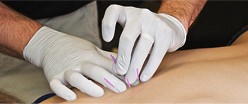

Functional dry needling (FDN) is a technique used by physical therapists to treat a variety of musculoskeletal conditions. FDN involves the insertion of thin, sterile needles into the skin and muscles to stimulate the body’s natural healing response. At OSR Physical Therapy, our experienced therapists use functional dry needling to help patients recover from injuries, reduce pain, and improve their overall function.
1. Muscle tension and pain: Dry needling can help reduce muscle tension and pain by releasing trigger points, or tight areas within the muscle.
2. Back pain: Dry needling can help relieve pain associated with conditions such as sciatica, herniated discs, and spinal stenosis.
3. Headaches: Dry needling can be used to treat tension headaches, migraines, and other types of headaches.
4. Joint pain: Dry needling can help relieve pain and stiffness in joints such as the shoulder, knee, and hip.
5. Sports injuries: Dry needling can help accelerate the healing process for sports-related injuries such as strains, sprains, and tendonitis.
6. Fibromyalgia: Dry needling can help reduce the pain and muscle stiffness associated with fibromyalgia.
At OSR Physical Therapy, our therapists are trained in functional dry needling and use this technique as part of a comprehensive treatment plan. We believe in using evidence-based practices to help our patients achieve their treatment goals and improve their overall quality of life.
If you are experiencing pain or discomfort and are looking for a non-invasive treatment option, functional dry needling may be right for you. Contact us today to schedule an appointment and learn more about how we can help you achieve your health and wellness goals.
Contact UsIf you have any questions about dry-needling services, please contact Meaghan Cox, DPT, Jason Kopp, LAT, Tanner King, DPT, Taylor Carlson, DPT, Ashley Fedie, DPT, Siri Sviggum, DPT or Brian Ommen, DPT
Dry-Needling is now being offered at all five of our locations! Call us now to set up an appointment!
